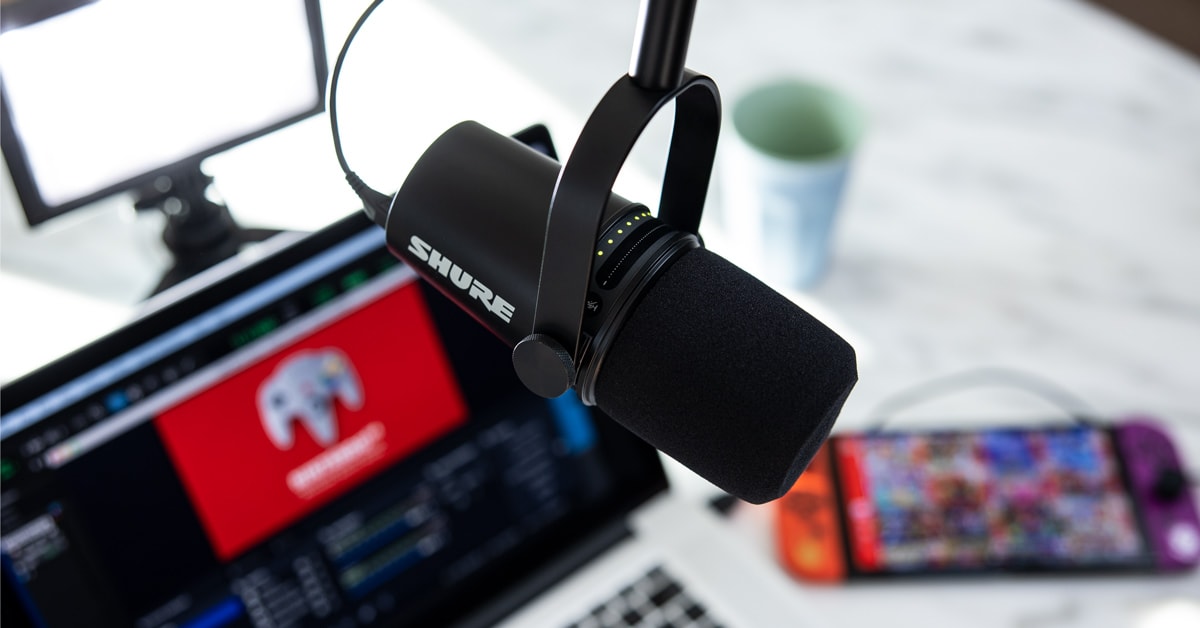Whether you’re a gamer, livestreamer or YouTuber, there’s a microphone that’s purpose-designed to suit your needs. And no matter if you’re doing it for work or play—or both—you’ll need the right setup to optimize your and your audience’s experience. We’ve curated this collection of the best mics for gaming, streaming and YouTube to untangle the clutter that is today’s vast world of microphone options, so you can get to doing your thing in the best possible way—whatever your level of audio tech expertise and existing gear, or lack thereof.
Table of Contents
Best Microphone Headset for Gaming
JBL Quantum ONE USB Over-Ear Professional Gaming Headset
Best Microphones for Streaming
Earthworks ICON Pro XLR Broadcast Microphone
Audio Technica AT2020 USB-X Cardioid Condenser Microphone
Best Microphones for YouTube
Audio-Technica AT2040 Hypercardioid Dynamic Podcast Microphone
Lauten Audio LS-208 Front-Address Large-Diaphragm Condenser Microphone
Shure SM7B and MV7 Microphones
Electro-Voice RE20 Dynamic Broadcast Microphone
In Closing
Best Microphone Headset for Gaming
While quality standalone mics would technically deliver superior audio, their size, stationary nature and sometimes fragility don’t make them ideal for gaming. That’s why gaming headsets have become as popular as they are, and it’s the reason we’re whittling down our recommendations to gear that’s specially designed to handle all your mic and listening needs in one wearable set. Both of our chosen headsets come with software that allows you to customize EQ and other settings to your liking, in addition to onboard mute and volume controls. And some headsets, like the JBL Quantum One, feature built-in spatial orientation technology that can give you a competitive advantage over your opponents—if winning is your thing. (We figure it is since you’re reading this.)
JBL Quantum ONE USB Over-Ear Professional Gaming Headset
No stranger to pro audio, JBL designed this one to turn heads—literally. The head-tracking technology on the Quantum ONE, dubbed the QuantumSPHERE 360, lends spatial surround sound to help fully immerse you into your virtual world. The Quantum ONE sports active noise canceling that’s specially tuned for gaming, hi-res 50 mm drivers and a detachable boom mic with voice-focusing noise suppression, so you can hear and be heard, loud and clear. With its compatibility across all gaming platforms and QuantumENGINE software suite customization, it’s as ready for action as you are. Plus, let’s be real—its changing-color LED accents are next level in the looks department.
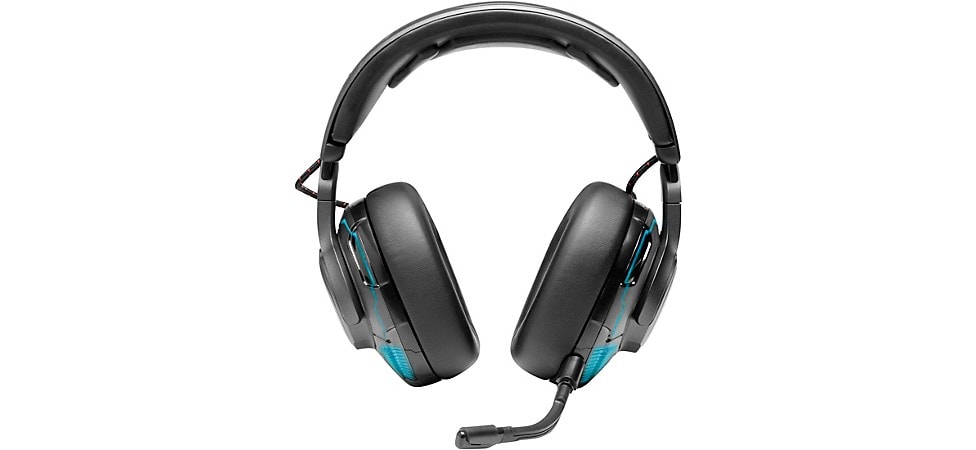
Pictured: JBL Quantum One USB Wired Over-Ear Professional Gaming Headset
Best Microphones for Streaming
Livestreamers broadcasting on Twitch, Facebook and other platforms come in many forms, but there are a couple of crucial common constants when it comes to their microphone needs: Versatility and reliability. Of course, quality doesn’t hurt either. One good way to measure that is frequency range, which is measured in Hz (hertz)—the range of human hearing tends to be from 20Hz–20kHz, from lowest to highest pitch—and many look to this as a quantitative indicator of its sonic quality. Within a mic’s frequency spectrum are certain areas (e.g., lows, mids or highs) that are more pronounced or dampened than others.
Whether a microphone has a dynamic or condenser capsule is also crucial. Dynamic mics are great for situations where a room is not acoustically treated, or a location has some background noise that isn’t intended as a part of the stream or recording. Condenser microphones, on the other hand, are far more sensitive, and tend to pick up more detail—especially in the upper frequencies. This makes condensers ideal for studio environments where room reflections, caused by hard surfaces like wood floors, glass or concrete, are minimized by way of acoustic paneling or foam, and strategic mic and sound source placement. The farther away from any hard-surface walls, floors, ceilings and windows, as well as noise from computer hum, fans, air conditioning or a nearby street, the better when it comes to dealing with mics—especially condensers. Another thing to consider with condensers is that they usually require 48V of phantom power, which gives them the juice to function. USB condensers will supply that power by default, whereas mic preamps, usually onboard audio interfaces, have a dedicated 48V button or switch you’ll need to toggle to get signal from your XLR condenser.
Another factor is the polar pattern. For example, a cardioid polar pattern will capture sound that is directly in front of the capsule, whereas a bidirectional (also known as “figure-8” or “figure of 8”) picks up sound directly in front of and behind the mic. The latter is great for interview situations where you only have one mic input to work with. Areas outside of the polar pattern are known by audio geeks as “off-axis.” Off-axis rejection is something that can be used to your benefit when it comes to mitigating unwanted background noise from the other side of the mic. Omnidirectional or “omni” polar patterns get their sound from all around—think of a single mic in the middle of a conference room desk. Anyone who speaks can be heard just as well as someone sitting adjacent or across. Many mics offer just one polar pattern, whereas a multitude of others give you switchable options depending on your use case. The size, material, build quality and number of capsules also play a role.
Earthworks ICON Pro XLR Broadcast Microphone
The Earthworks ICON Pro is an excellent choice if you can swing the expense for it, as well as an interface with a mic pre, since it has an XLR out. Boasting a frequency response of 20Hz to 30kHz, it covers all the lows, highs and in-betweens you’ll ever need. It’s a lovely choice for livestreaming, as it has some forgiving qualities. For example, you don’t need to be right on the mic to be heard clearly, and while it’s a condenser, it’s less sensitive than most others, meaning your space doesn’t have to be acoustically treated for your audio to sound great. What’s more, its built-in pop filter stops plosives—those pesky “p” and “b” sounds that can be such a challenge, if not impossible, to edit—in their tracks. Finally, its easily adjustable stand makes it a cinch to change the mic’s angle to wherever you need it—a seemingly simple task that isn’t always so seamless.
![]()
Pictured: Earthworks ICON Pro XLR Broadcast Microphone
Audio-Technica AT2020USB-X Cardioid Condenser Microphone
Like the Yeti, Audio-Technica’s AT2020 USB mic was one of the first big players to enter the mass market for non-audio-pro content creators—but teetering on the edge of professional quality, like its XLR-equipped AT2020 counterpart. The AT2020USB-X cardioid condenser mic marks a decided turn for the content creator crowd, and its non-interface-dependent USB compatibility make it perfect for livestreamers. Its 20Hz–20kHz frequency range, touch-sensitive mute button, and clever positioning of its USB terminal—by the mount—present an irresistible combination of function, form and value.
For those who are looking to go all in on a new studio setup, there is also a bundled version that includes the widely beloved ATH-20x professional monitor headphones and an adjustable boom arm to hold your mic.
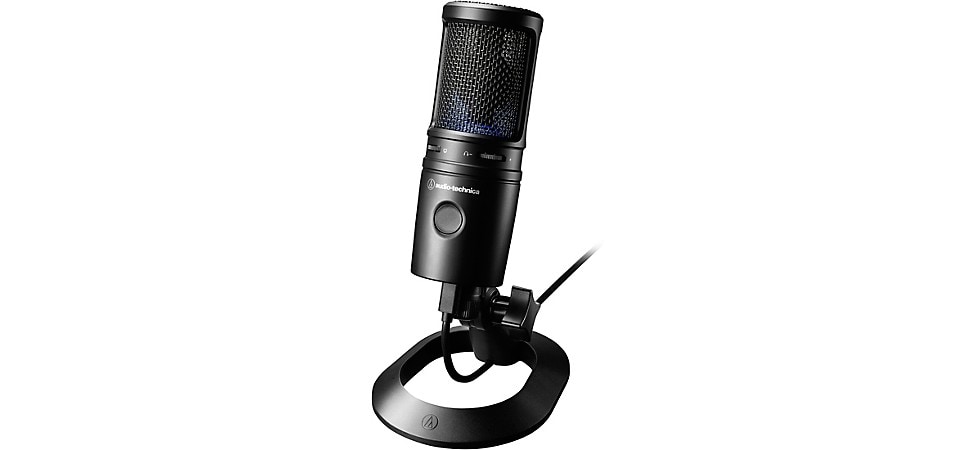
Pictured: Audio-Technica AT2020USB-X Condenser USB Microphone
Best Microphones for YouTube
In addition to all the characteristics that make the aforementioned mics great for streaming, creators who are looking to publish more permanent content on YouTube, and the like—podcasters included—may benefit from some added production polish. For those who have a more stationary setup where a mic is consistently on camera, in front of the presenter and/or host and interviewees, a more specialized investment may be in order. But make no mistake— affordable choices are also abundant. Keep in mind that should you opt for an XLR-equipped mic, you’ll need an audio interface going into your computer with a DAW (digital audio workstation)—or a field recorder like a Zoom H series or TASCAM Portacapture.
Audio-Technica AT2040 Hypercardioid Dynamic Podcast Microphone
With its hypercardioid pattern and dynamic capsule, the Audio-Technica AT2040 podcast mic does an impeccable job of capturing voice while rejecting extraneous sounds on the periphery. Made by a very reputable pro audio brand, the AT2040 delivers silky-smooth audio along with a professional aesthetic that looks great on camera and punches well above its weight class. The included stand with shockmount ensures your needs are met, so long as you have an interface to connect your XLR output to.
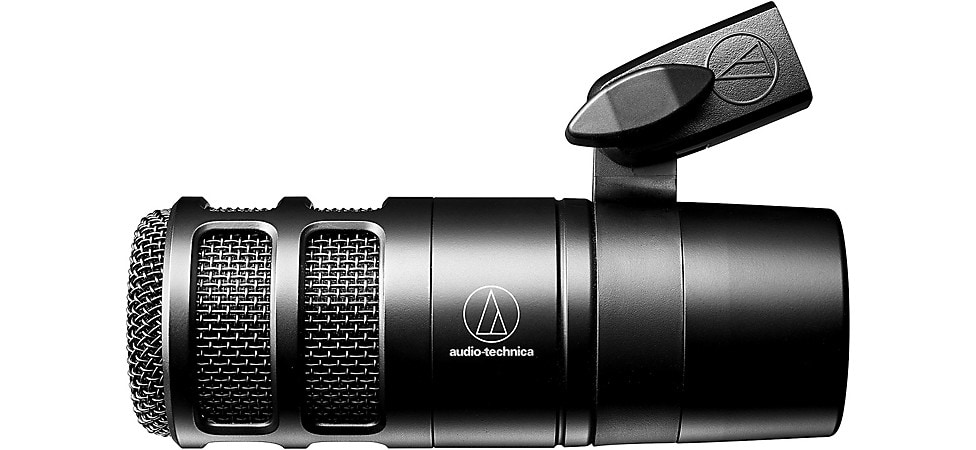
Pictured: Audio-Technica AT2040 Hypercardioid Dynamic Podcast Microphone
Lauten Audio LS-208 Front-Address Large-Diaphragm Condenser Microphone
Based in Silicon Valley, the designers at Lauten Audio pride themselves on making mics for modern utility. The LS-208 is no exception to this trend. Its front-address large-diaphragm condenser capsule is catered to content creators with more aspirational audio standards. With its ability to handle high SPL (sound pressure level), and onboard high- and low-pass filter switches, it can eliminate low-frequency rumble or high-frequency background noise right at the start of your signal flow. Even the minor details are impressive—the included spider shockmount is ingeniously engineered to be compact and low profile, yet beautiful and complementary to the mic itself.
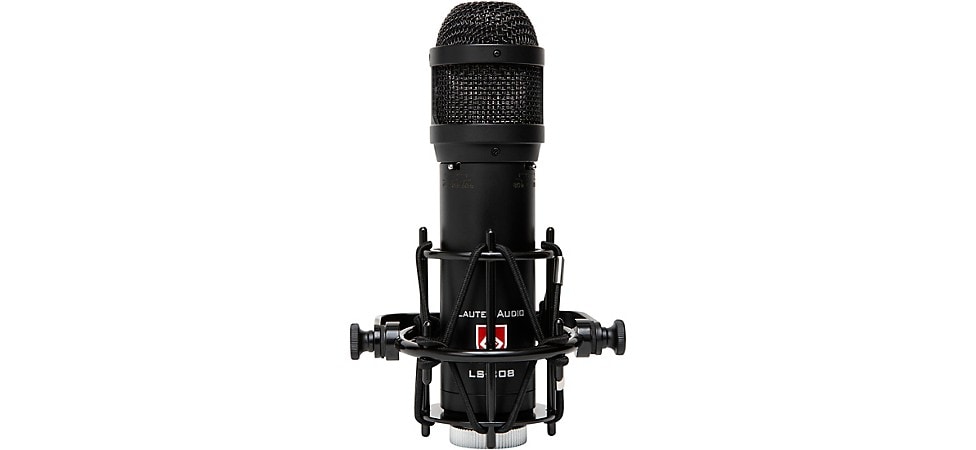
Pictured: Lauten Audio LS-208 Front-Address Large-Diaphragm Condenser Microphone
Shure SM7B and MV7 Microphones
Shure’s SM7B dynamic XLR mic has graced studios of all budgets since its beginnings. Oh, and it was used to record vocals on the best-selling album of all time, Michael Jackson’s Thriller—no big deal … Well, this mic is a big deal, and its iconic status is justified. Its internal suspension system protects your signal from light mechanical vibration, its electromagnetic shielding bucks low-frequency hum, and its swivel mount makes it ideal for world-class recording studios and YouTubers’ bedroom setups alike. And for such a legendary piece of gear, it’s affordable. But perhaps you need a bit more level to capture a soft-spoken podcast guest, an actor performing loud and soft passages, or rectifying a low-gain mixer preamp. The Shure SM7dB retains the SM7B's celebrated sound while adding a built-in, switchable preamp that offers either 18dB or 28dB of gain.
Whether you have an interface or just a computer—or have a more established rig at home, but also want something for the road—the SM7B has an aesthetically similar sibling, the MV7, that can deliver superbly on all fronts. The Shure MV7 podcast microphone gives you a plethora of options that the SM7B doesn’t, like XLR and USB outputs, built-in headphone output for direct monitoring, and a touch control strip for gain and monitor level adjustments. If you want a discreet way to monitor your mix, there’s even a content creator bundle that includes the SE215 earphones. Shure also offers the MV7+. In addition to the features that are present in the MV7, the MV7+ boasts enhanced onboard DSP processing, an LED touch panel that serves as an audio level meter and mute control.
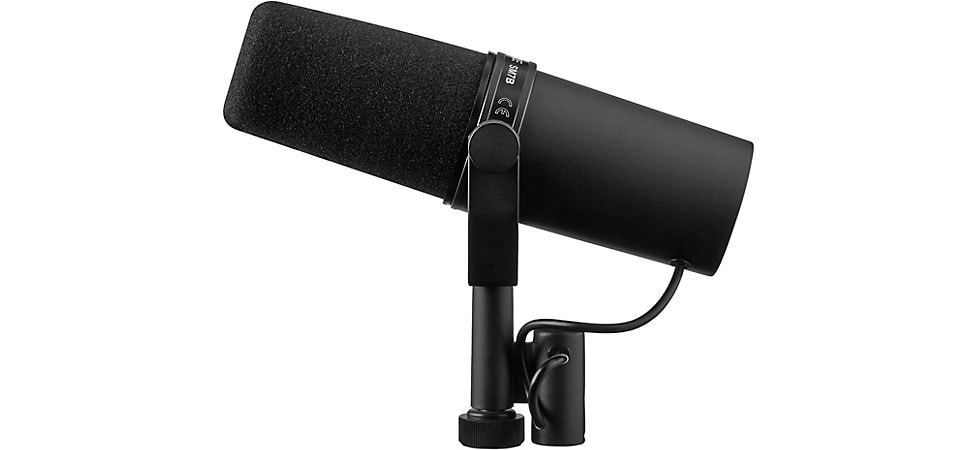
Pictured: Shure SM7B Cardioid Dynamic Microphone
Electro-Voice RE20 Dynamic Broadcast Microphone
Before becoming ubiquitous on YouTube, the Electro-Voice RE20 large-diaphragm dynamic mic was a familiar sight in broadcast studios across the globe. From its substantial, patently prestigious steel housing to its sublime sonic characteristics, it’s worthy of envy. The RE20 features Continuously Variable-D technology, which essentially eliminates the proximity effect—the bass boost you get as you get very close to the mic. It also reaps the benefits of being a true cardioid mic, with fantastic 180° off-axis rejection, meaning any sound coming from behind the mic is greatly diminished. Few mics have achieved the industry standard level that the RE20 has, thanks to its ability to highlight a desirable frequency range in the voice, as well as various instruments for its uniquely musical quality.
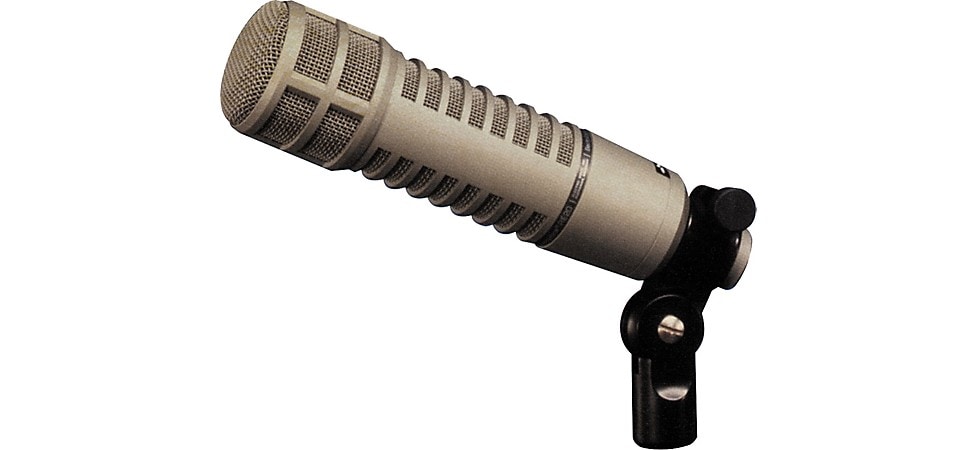
Pictured: Electro-Voice RE20 Dynamic Broadcast Microphone
In Closing
Regardless of application, whether it be for gaming, livestreaming, podcasting or YouTube, there’s a microphone that will satisfy your needs. Now that you know what to look for in a mic, from capsule type to frequency range, you can make your investment—whatever your budget allows for—with confidence.
.jpeg)






